英语语法-介词用法及固定搭配
介词与连词的运用与搭配
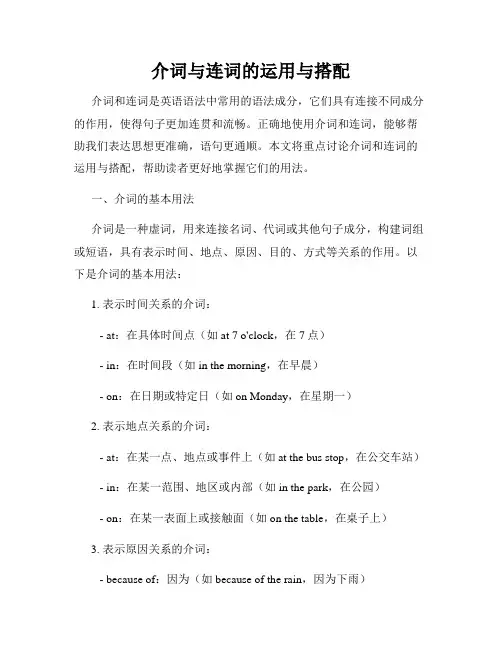
介词与连词的运用与搭配介词和连词是英语语法中常用的语法成分,它们具有连接不同成分的作用,使得句子更加连贯和流畅。
正确地使用介词和连词,能够帮助我们表达思想更准确,语句更通顺。
本文将重点讨论介词和连词的运用与搭配,帮助读者更好地掌握它们的用法。
一、介词的基本用法介词是一种虚词,用来连接名词、代词或其他句子成分,构建词组或短语,具有表示时间、地点、原因、目的、方式等关系的作用。
以下是介词的基本用法:1. 表示时间关系的介词:- at:在具体时间点(如at 7 o'clock,在7点)- in:在时间段(如in the morning,在早晨)- on:在日期或特定日(如on Monday,在星期一)2. 表示地点关系的介词:- at:在某一点、地点或事件上(如at the bus stop,在公交车站) - in:在某一范围、地区或内部(如in the park,在公园)- on:在某一表面上或接触面(如on the table,在桌子上)3. 表示原因关系的介词:- because of:因为(如because of the rain,因为下雨)- due to:由于(如due to his absence,由于他的缺席)4. 表示目的关系的介词:- for:为了(如study hard for the exam,为了考试努力学习)- to:向、给予某人(如give the book to me,把书给我)- with:用、以(如write with a pen,用钢笔写)5. 表示方式关系的介词:- by:通过、用(如travel by train,乘火车旅行)- in:以…方式(如in English,在英语中)二、连词的基本用法连词是一种虚词,用来连接两个词、短语、句子或句子成分,构建复合句,表示并列、因果、条件、让步、递进等关系。
以下是连词的基本用法:1. 表示并列关系的连词:- and:和、与(如apples and oranges,苹果和橙子)- or:或者(如tea or coffee,茶或咖啡)- but:但是(如I like him but he doesn't like me,我喜欢他但他不喜欢我)2. 表示因果关系的连词:- because:因为(如I stayed home because it was raining,因为下雨我呆在家里)- since:因为(如He has been living here since he was born,他从出生起就住在这里)3. 表示条件关系的连词:- if:如果(如I will go if you come,如果你来我就去)- unless:除非(如I won't go unless you invite me,除非你邀请我我才会去)4. 表示让步关系的连词:- although:尽管(如Although it was raining, we went out,尽管下雨,我们还是出去了)- though:虽然(如Though he is young, he is very talented,虽然他很年轻,但很有才华)5. 表示递进关系的连词:- and:而且、又(如I bought a book and a pen,我买了一本书和一支笔)- furthermore:而且、此外(如Furthermore, the weather is getting better,此外,天气越来越好)三、介词与连词的搭配运用正确地搭配介词和连词,能够使句子更加准确、流畅。
介词短语的固定搭配与用法
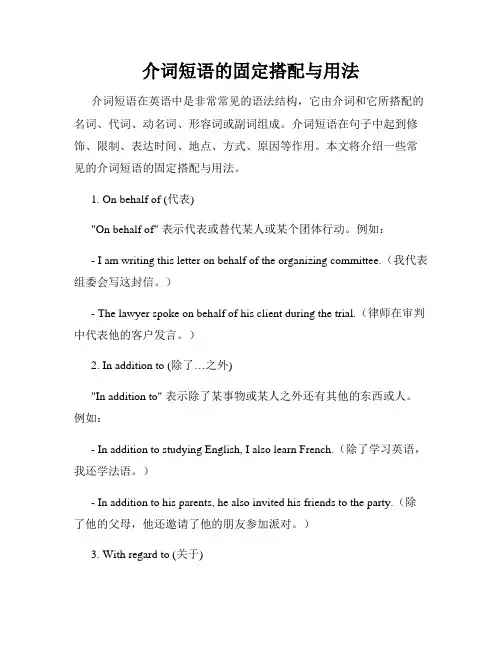
介词短语的固定搭配与用法介词短语在英语中是非常常见的语法结构,它由介词和它所搭配的名词、代词、动名词、形容词或副词组成。
介词短语在句子中起到修饰、限制、表达时间、地点、方式、原因等作用。
本文将介绍一些常见的介词短语的固定搭配与用法。
1. On behalf of (代表)"On behalf of" 表示代表或替代某人或某个团体行动。
例如:- I am writing this letter on behalf of the organizing committee.(我代表组委会写这封信。
)- The lawyer spoke on behalf of his client during the trial.(律师在审判中代表他的客户发言。
)2. In addition to (除了…之外)"In addition to" 表示除了某事物或某人之外还有其他的东西或人。
例如:- In addition to studying English, I also learn French.(除了学习英语,我还学法语。
)- In addition to his parents, he also invited his friends to the party.(除了他的父母,他还邀请了他的朋友参加派对。
)3. With regard to (关于)"With regard to" 表示在某个方面或某个问题上,用于引出话题或讨论。
例如:- With regard to your request, we will get back to you as soon as possible.(关于你的要求,我们会尽快给你回复。
)- He has made a decision with regard to his future career.(他已经就自己未来的职业做出了决定。
英语语法-介词用法与固定搭配
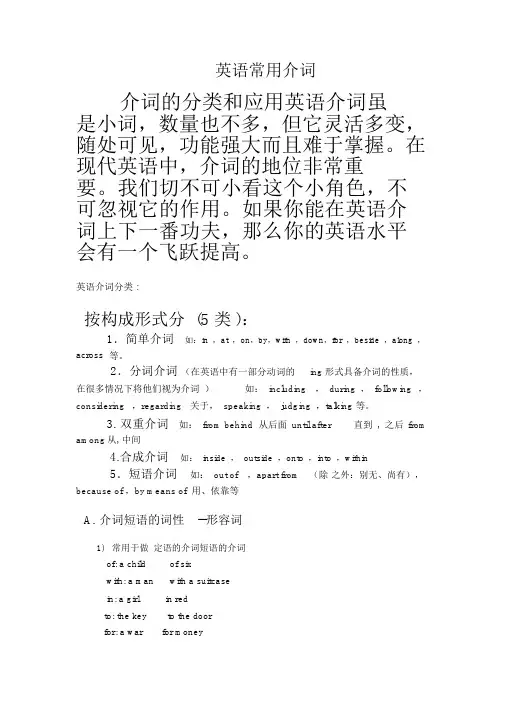
英语常用介词介词的分类和应用英语介词虽是小词,数量也不多,但它灵活多变,随处可见,功能强大而且难于掌握。
在现代英语中,介词的地位非常重要。
我们切不可小看这个小角色,不可忽视它的作用。
如果你能在英语介词上下一番功夫,那么你的英语水平会有一个飞跃提高。
英语介词分类 :按构成形式分 (5 类 ):1.简单介词如:in,at,on,by,with,down,for,beside,along,across等。
2.分词介词(在英语中有一部分动词的ing 形式具备介词的性质,在很多情况下将他们视为介词)如:including,during,following,considering,regarding关于,speaking,judging,talking等。
3. 双重介词如:from behind从后面until after直到,之后from among从, 中间4.合成介词如:inside,outside,onto,into,within5.短语介词如:out of,apart from(除之外:别无、尚有),because of ,by means of 用、依靠等A. 介词短语的词性--形容词1)常用于做定语的介词短语的介词of: a child of sixwith: a man with a suitcasein: a girl in redto: the key to the doorfor: a war for moneyabout: an agreement about trade2)常用于做表语的介词短语的介词at: She was at a loss.beyond ;The road is beyond the hillin: He’ s still in danger.of: It’ s of no value.on: He is on guard. 值班out of: I’ m out of job.under: He ’s under forty..3)用于做宾语补足语:I saw George A cold kept him at work .in bed for 7 days.B. 介词短语的词性—副词1)做状语,主要用于修饰谓语:He has been here since Monday .Bake it is for two hours.2) 用于 be+adj. 结构:She is afraid of snakes.I ’ m sorry about that.3)修饰非谓语动词:I asked to speak to the headmaster.介词 -- 短语动词中的关键角色含有介词的短语动词1. v.+ prep : agree with/to/on/in,answer for, ask for,come across, go after, live on, run into, head for, look for/after/at等。
初中英语固定搭配总结大全
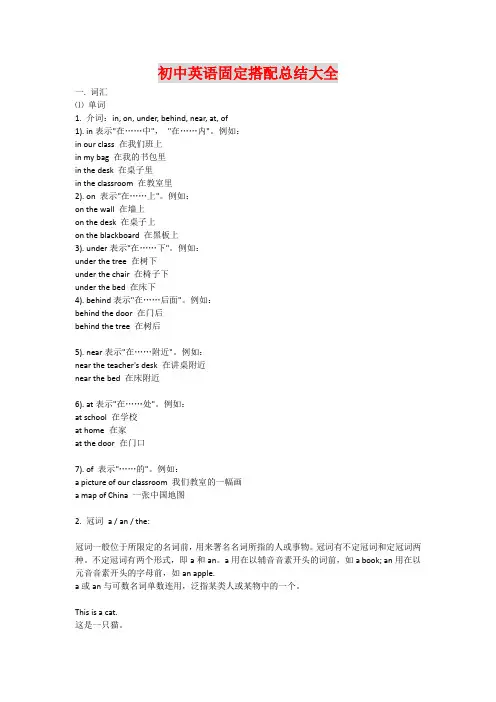
初中英语固定搭配总结大全一. 词汇⑴单词1. 介词:in, on, under, behind, near, at, of1). in表示"在……中","在……内"。
例如:in our class 在我们班上in my bag 在我的书包里in the desk 在桌子里in the classroom 在教室里2). on 表示"在……上"。
例如:on the wall 在墙上on the desk 在桌子上on the blackboard 在黑板上3). under表示"在……下"。
例如:under the tree 在树下under the chair 在椅子下under the bed 在床下4). behind表示"在……后面"。
例如:behind the door 在门后behind the tree 在树后5). near表示"在……附近"。
例如:near the teacher's desk 在讲桌附近near the bed 在床附近6). at表示"在……处"。
例如:at school 在学校at home 在家at the door 在门口7). of 表示"……的"。
例如:a picture of our classroom 我们教室的一幅画a map of China 一张中国地图2. 冠词a / an / the:冠词一般位于所限定的名词前,用来署名名词所指的人或事物。
冠词有不定冠词和定冠词两种。
不定冠词有两个形式,即a和an。
a用在以辅音音素开头的词前,如a book; an用在以元音音素开头的字母前,如an apple.a或an与可数名词单数连用,泛指某类人或某物中的一个。
This is a cat.这是一只猫。
介词的用法及与动词搭配的规律
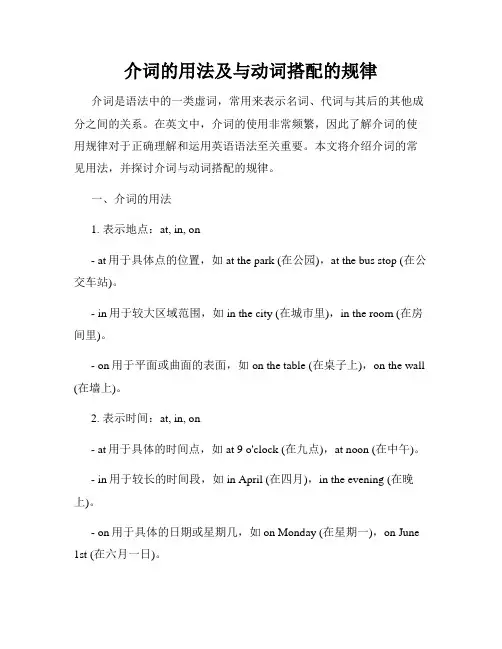
介词的用法及与动词搭配的规律介词是语法中的一类虚词,常用来表示名词、代词与其后的其他成分之间的关系。
在英文中,介词的使用非常频繁,因此了解介词的使用规律对于正确理解和运用英语语法至关重要。
本文将介绍介词的常见用法,并探讨介词与动词搭配的规律。
一、介词的用法1. 表示地点:at, in, on- at用于具体点的位置,如at the park (在公园),at the bus stop (在公交车站)。
- in用于较大区域范围,如in the city (在城市里),in the room (在房间里)。
- on用于平面或曲面的表面,如on the table (在桌子上),on the wall (在墙上)。
2. 表示时间:at, in, on- at用于具体的时间点,如at 9 o'clock (在九点),at noon (在中午)。
- in用于较长的时间段,如in April (在四月),in the evening (在晚上)。
- on用于具体的日期或星期几,如on Monday (在星期一),on June 1st (在六月一日)。
3. 表示方式:by, with- by表示通过某种工具或方法,如by car (乘坐汽车),by email (通过电子邮件)。
- with表示伴随的方式,如with a smile (带着微笑),with great enthusiasm (充满热情地)。
4. 表示原因:because of, due to- because of和due to都可以表示原因,但due to用于正式场合,后接名词或名词短语,而because of更常用,并且后接名词、代词或动名词短语。
5. 表示目的:for, to- for表示目标或目的,如study for the exam (为了考试而学习)。
- to表示动作的方向或目标,如go to school (去学校)。
初中英语知识归纳常用介词短语和固定搭配的使用场景
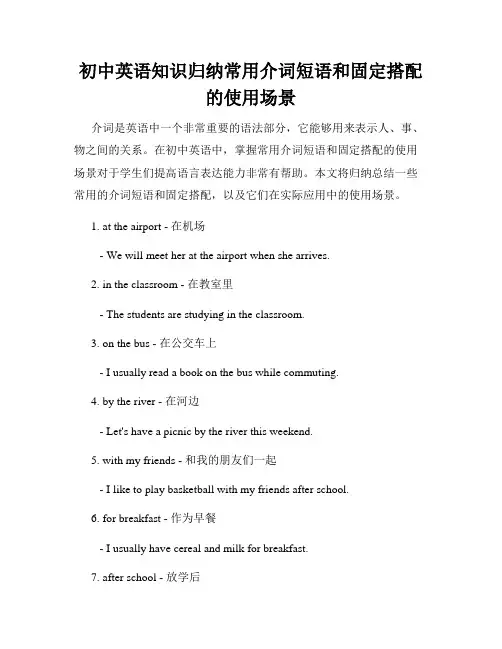
初中英语知识归纳常用介词短语和固定搭配的使用场景介词是英语中一个非常重要的语法部分,它能够用来表示人、事、物之间的关系。
在初中英语中,掌握常用介词短语和固定搭配的使用场景对于学生们提高语言表达能力非常有帮助。
本文将归纳总结一些常用的介词短语和固定搭配,以及它们在实际应用中的使用场景。
1. at the airport - 在机场- We will meet her at the airport when she arrives.2. in the classroom - 在教室里- The students are studying in the classroom.3. on the bus - 在公交车上- I usually read a book on the bus while commuting.4. by the river - 在河边- Let's have a picnic by the river this weekend.5. with my friends - 和我的朋友们一起- I like to play basketball with my friends after school.6. for breakfast - 作为早餐- I usually have cereal and milk for breakfast.7. after school - 放学后- We often play soccer after school in the park.8. in front of the library - 在图书馆前面- I will wait for you in front of the library at 5 o'clock.9. on the table - 在桌子上- The keys are on the table, please don't forget to take them.10. under the tree - 在树下- It's nice to read a book under the tree on a sunny day. 11. with a pen - 用一支笔- Can you please sign the document with a pen?12. by car - 乘坐汽车- We traveled to the countryside by car last summer.13. in the park - 在公园里- Let's meet in the park and have a picnic.14. on the wall - 在墙上- Hang the painting on the wall in the living room.15. for dinner - 用于晚餐- I cooked chicken and rice for dinner tonight.16. at the cinema - 在电影院- Let's watch a movie together at the cinema this weekend.17. in the museum - 在博物馆里- We learned a lot about history in the museum.18. on the computer - 在电脑上- I am writing an essay on the computer for my English class.19. with a smile - 带着微笑- He greeted everyone with a smile on his face.20. by the beach - 在海滩旁边- We had a wonderful time building sandcastles by the beach.以上是一些常见的介词短语和固定搭配的使用场景,掌握它们对于初中学生提高英语口语和写作能力会非常有帮助。
初中英语语法:介词的用法归纳
初中英语语法:介词的用法归纳介词是一种用来表示词与词,句子与句子之间关系的词。
介词是一种虚词,不能独立使用。
介词之后一般有名词或代词(宾格)或相当于名词的其他词类、短语或从句作它的宾语,即构成介词短语。
有些介词是由两个以上的词构成的短语介词,如:out of(从…中出来),because of(因为),away from(距离…),on top of(在…顶上),ever since(自从…),next to(在…隔壁),according to(根据…),in front of(在…前方)等。
一、介词的分类1、按构成方式,可分为:①简单介词:即一个介词;②合成介词:由两个介词构成合成词;③短语介词:由短语构成;④双重介词:由两个介词搭配而成;⑤分词介词:由现在分词转化而来;⑥兼类介词:由形容词直接转化而来;2、按所表示的意义,可分如下几类:①地点(位置、范围)介词;②方向(目标趋向)介词;③时间介词;④方式介词;⑤涉及介词;⑥其它介词:目的介词,原因介词,比较介词,伴随/状态介词。
二、介词短语的句法作用介词与其宾语一起构成的短语叫做介词短语,可在句子中充当一定成分,通常用作状语、定语和表语和宾语补足语。
如:The man camedown the stairs。
(状)(那个人走下楼来)The womanwith a flower on her headisfrom the countryside.(定)(头上戴花的妇女来自乡下)The teacher is nowwith the pupils.(表)(老师现在和学生在一起)When she woke up,she found herselfin hospital.(宾补)当她醒来时,发现自己已经在医院里。
三、介词短语在句子中的位置介词短语做状语时,如果表示时间/地点,可以放在句首或句尾。
如果表示方向/方式/伴随/涉及/原因/目的/比较,一般放在句尾;介词短语作表语时放在连系动词之后;介词短语作定语时,只能放在被修饰的名词之后。
初中英语知识归纳常见介词短语和固定搭配
初中英语知识归纳常见介词短语和固定搭配介词是英语中一个非常重要的语法成分,它在句子中起着连接词语和短语的作用。
掌握常见的介词短语和固定搭配对于初中生来说非常重要。
以下是一些常见的介词短语和固定搭配,希望能够帮助初中生们更好地学习和运用英语。
1. in front of:在...前面例句:The car is parked in front of the house.(汽车停在房子前面。
)2. on top of:在...上方例句:The book is on top of the table.(书在桌子上方。
)3. at the back of:在...后面例句:The students are sitting at the back of the classroom.(学生们坐在教室后面。
)4. by the side of:在...旁边例句:There is a park by the side of the river.(河边有一个公园。
)5. between...and...:在...之间例句:The library is between the school and the post office.(图书馆在学校和邮局之间。
)6. under the tree:在树下例句:The children are playing under the tree.(孩子们正在树下玩耍。
)7. behind the door:在门后例句:The key is behind the door.(钥匙在门后。
)8. in the middle of:在...的中间例句:The cat is sleeping in the middle of the road.(猫在路中间睡觉。
)9. on the left/right:在左边/右边例句:The bank is on the left of the supermarket.(银行在超市的左边。
介词用法详解常见介词的正确搭配与固定搭配
介词用法详解常见介词的正确搭配与固定搭配介词是英语语法中非常重要的一部分,它用来表示名词、代词或动词与其他词之间的关系。
正确使用介词能够使语言更加地准确、自然。
本文将详细介绍一些常见介词的正确搭配与固定搭配,以帮助读者更好地理解和掌握这些用法。
一、关于in的用法:1. 表示地点:in表示在某个范围、界限或地方之内。
例如:in the park(在公园里)、in the room(在房间里)。
2. 表示时间:in常用来表示具体的某个时间段。
例如:in the morning(在上午)、in the summer(在夏季)。
3. 表示状态、情感:in用于表示某种状态或情感。
例如:in love(恋爱中)、in a hurry(匆忙)。
二、关于on的用法:1. 表示位置:on用于描述某事物所在的位置或表面。
例如:on the table(在桌子上)、on the wall(在墙上)。
2. 表示时间:on主要用于表示某一天、星期或具体的时间点。
例如:on Monday(在星期一)、on Christmas Day(在圣诞节)。
3. 表示方式、状态:on常用来表示某种方式或状态。
例如:on foot (步行)、on fire(着火)。
三、关于at的用法:1. 表示地点:at用于表示具体的某个地点或位置。
例如:at the airport(在机场)、at the bus stop(在公交车站)。
2. 表示时间:at用于表示具体的某一时刻。
例如:at 8 o'clock(在8点钟)、at midnight(在午夜)。
3. 表示某种状态、情感:at常用来表示某种状态或情感。
例如:at peace(和平)、at a loss(困惑)。
四、关于to的用法:1. 表示方向、目的地:to用于表示某个方向或目的地。
例如:go to school(去学校)、fly to Beijing(飞往北京)。
2. 表示时间:to用于表示某个时间点或一段时间之后。
英语语法介词用法
英语语法介词用法工欲善其事,必先利其器。
愿你从容不迫,待你潇洒凯旋。
中考不退却,逆袭全世界。
今日有心苦勤奋,明朝一举步青云。
下面是我给大家带来的英语语法介词用法,欢迎大家阅读参考,我们一起来看看吧!英语语法:介词介词介词不能单独使用,必需和名词、代词或动名词构成介词短语,在句中做表语,定语、状语、补语等成分。
依据介词的用法,通常可以分为:时间、地点、趋向和其他四类介词。
一、表示时间的介词:(1) at 示时刻、时间的某一点 at six, at noon, at half past one, at that time / momenton 体的某一天 on Sunday, on Friday afternoon, on a cold morning, on the morning of … on March 12th, 2021in 示周、月、季节、年以及泛指的上、下午,晚上 in spring, in 2021, in the morning,在his, last,that, next, every 等词前面不用介词this afternoon, last Sunday, every morning区分:next week -------- the next week(2) by “在……前” 多和完成时态连用till “直到……才” I’ll wait here till you come back.until “不到……就不” 常和until连用I’ll not leave until youcome back.(3) in 过……以后, 大多用于将来时 after 多用于过去时(4) since + 过去的一个时间点 (表示时间段, 从……开头到现在) for + 一段时间二、表示场所、方向的介词:(1)at 表示比较详细的地点 at 37 Renming Roadin 表示比较宽敞的地点 in Renming Street(2)above斜上方-------below斜下方 over正上方-------under正下方on 两物体有接触(3) be tween…and..在……和……之间 among在……中间(三者以上)(4) across (从物体表面)跨越, 越过 through (从物体中间)穿透, 穿越(5)in 在……里面(表示静止的位置) into 进入,表示运动方向,常用在表示动作的动词之后, 如 go, come, walk, jump, run 等 into的反义词是out of(6)to 到 (目底地)或方向 towards 指朝着某方向,而不是目的地.He walked towards the beach.三、其它介词1.with (1)在一起; (2)有; (3)用某种工具in 用什么材料或语言,或表示衣着,声调特点等by 用......手段2.Like 象......一样as 作为;根据,象......一样(连词)+ 句子3.for(1)为了(表示目的或缘由) (2)(后面加一段时间)表示时间段英语中考:介词短语[介词短语聚焦]“介词+名词/代词”所构成的短语称为介词短语。
- 1、下载文档前请自行甄别文档内容的完整性,平台不提供额外的编辑、内容补充、找答案等附加服务。
- 2、"仅部分预览"的文档,不可在线预览部分如存在完整性等问题,可反馈申请退款(可完整预览的文档不适用该条件!)。
- 3、如文档侵犯您的权益,请联系客服反馈,我们会尽快为您处理(人工客服工作时间:9:00-18:30)。
英语常用介词介词的分类和应用英语介词虽是小词,数量也不多,但它灵活多变,随处可见,功能强大而且难于掌握。
在现代英语中,介词的地位非常重要。
我们切不可小看这个小角色,不可忽视它的作用。
如果你能在英语介词上下一番功夫,那么你的英语水平会有一个飞跃提高。
英语介词分类:按构成形式分(5类):1.简单介词如:in,at,on,by,with,down,for,beside,along,across等。
2.分词介词(在英语中有一部分动词的ing形式具备介词的性质,在很多情况下将他们视为介词)如:including,during,following,considering,regarding关于,speaking,judging,talking等。
3.双重介词如:from behind从后面 until after直到…之后from among从…中间4.合成介词如:inside,outside,onto,into,within5.短语介词如:out of,apart from(除之外:别无、尚有),because of,by means of用、依靠等A. 介词短语的词性--形容词1) 常用于做定语的介词短语的介词of: a child of sixwith: a man with a suitcasein: a girl in redto: the key to the doorfor: a war for moneyabout: an agreement about trade2)常用于做表语的介词短语的介词at: She was at a loss.beyond;The road is beyond the hill.in: He’s still in danger.of: It’s of no value.on: He is on guard.值班out of: I’m out of job.under: He’s under forty.3) 用于做宾语补足语:I saw George at work.A cold kept him in bed for 7 days.B. 介词短语的词性—副词1)做状语,主要用于修饰谓语:He has been here since Monday.Bake it is for two hours.2) 用于be+adj.结构:She is afraid of snakes.I’m sorry about that.3) 修饰非谓语动词:I asked to speak to the headmaster.介词--短语动词中的关键角色含有介词的短语动词1. v.+ prep :agree with/to/on/in, answer for, ask for, come across, go after, live on, run into, head for, look for/after/at 等。
2. v.+ adv. + prep : come up to达到, go in for从事、爱好, run out of,用光 do away with废除, keep up with, make up for, put up with等按表达意义分(3类):1. 时间介词,如:at, on, in, during, over, from, for, until 等。
2. 地点介词,如:at, on, in, across, to, over, between, inside, outside等。
3. 其它介词,如:by, with, about, except, instead of, due to, apart from等。
(一)表示时间的介词:1.at, on, in(1) at表示具体“在某一时刻、某一时点”或者把某一短时间看做某一时刻at 5:30 在5:30 at sunrise 日出时at night 夜间at noon 正午时 at midnight 在半夜at lunch 午饭时 at breakfast 在吃早饭时at first 首先 at the beginning( of……)在…开始时at last 最后 at the end(of……)最后at the moment 当时 at present 目前at that time 在那时at Christmas 在圣诞节at the age of…在…岁时(2) on表示“在具体某一天或某天的上、下午、早上、晚上”on Monday在星期一 on April 1st(on April the first)在四月一日on Monday morning on the weekend在周末on the following day 第二天on the following day evening 第二天晚上on New Year’s Day 在元旦 on school days在校期间on school’s day 在校庆日on a rainy day 在雨天 on a cold day 在寒冷的一天泛指上、下午、晚上、夜间时用in the morning/afternoon/evening, at night;但若指具体某一天的上述时段时,则一律用on。
如:On the afternoon of May 23.在五月二十三日下午。
I heard a shot on the morning of March 18.三月十八日早晨我听到一声枪响。
(3) in表示【泛指的上、下午、晚上】【在某月、季节、年、世纪】【表示将来时间翻译成“在……之后”】in the morning/afternoon/evening 在上午/下午/晚上in September 在九月in winter 在冬季in 1999 在1999年 in the 20th(21st) century 在20(21)世纪in one’ s life 在某人一生中 in two weeks 两周后 in the future 在将来in the daytime 在白天 in my school days 在我上学期间2.for, during, through(1) for“长达…之久”(表示过了多长时间)后接一段时间(与数词连用的时间名词)多与完成时连用。
I’ve been a soldier for 5 years.我入伍已5年了。
She has been ill for several days. 她已经病了几天了。
表示“持续一段时间”时,for后面必须跟“数字+时间名词”,而during 后决不可接数字。
(2) during表示“在……期间”during the night 在晚上during the fire在发生大火期间during the meeting 在开会期间during the meal 在吃饭过程中He visited many nice places during his stay here.在他逗留期间他参观了许多美丽的地方。
What did you do during the summer vacation? 你在暑假做了什么?(3) through表示“一直……,自始至终”They worked hard through the winter.整个冬天他们都在努力工作。
She treated me like her brother through these years. 这些年来她始终把我当哥哥对待。
3.from, since(1) from表示“等时间的起点”,作“从……”解,多用于“from…to/till…”中。
You can come anytime from Monday to Friday.周一至周五你什幺时间来都行。
The exam will start from 9:00am. 考试将从上午九点开始。
①from“从……(开始)”未必持续到现在,如:from 1995 to 1998.从1995年到1998年。
”②since而since是指“自从……以来一直持续到现在一般只与现在完成时连用,而from不受此限。
(2) since表示“自从……以来(直到现在)”He has been away from home since 1973.他自从1973年就离开了家乡。
We have known each other since ten years ago.我们十年前就认识了。
for与since表示一段时间,但for与时间段连用,而since与时间点连用。
如for two hours(持续)两小时;since last week自从上周直到现在4.before, by, till, until(1) before指“在……之前”Please come before ten o’clock.请10点以前来。
The meeting will end after 3:00pm. 会议将在下午三点后结束。
表示“在……以前”时,before与by基本可通用。
但by还有“最晚不迟于…”“截至……为止”之意,此时可与完成时(现在完成、过去完成)连用,而before一般不与完成时连用。
如:How many models have you made by the end of last month?截至上月底你做了多少个模型?(2) by指“不迟于,到……时为止,在……以前”动作完成I must finish my homework by lunch.午饭前我必须做完作业。
We had learned over 1000 words by the end of last term.到上学期末为止,我们已经学了1000多个单词了。
(3) till (until) “直到……为止”动作持续到什么时候You must wait for him till tomorrow.你必须一直等到他明天。
He didn’t come back until twelve o’clock last night.他昨晚下到12点才回来。
在肯定句中,till (until)必须与延续动词连用。
若与点动词连用,till (until)只能用于否定句中。
5.after,in,within①after表示“在……之后”,是before的反义词。
We’ll hold a party after dinner.晚餐后我们将举办晚会。
He got a cancer and died after a year.他患了癌症,一年后去世了。
